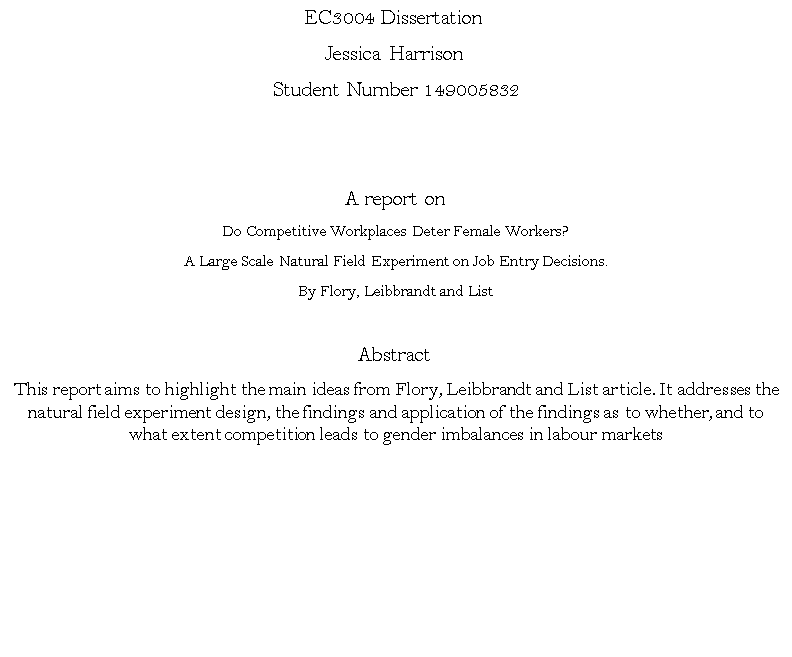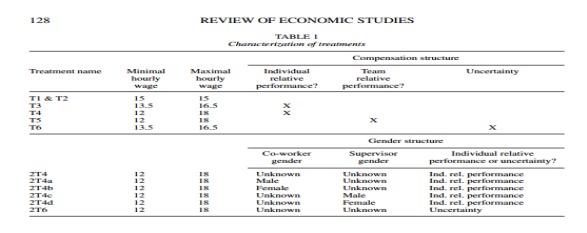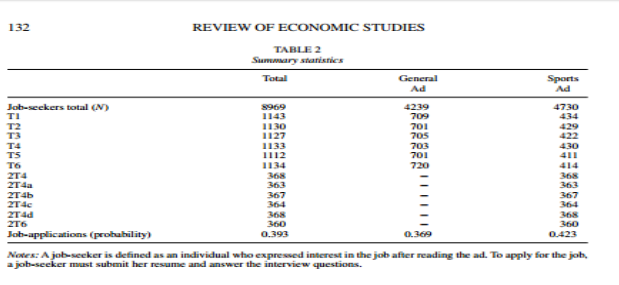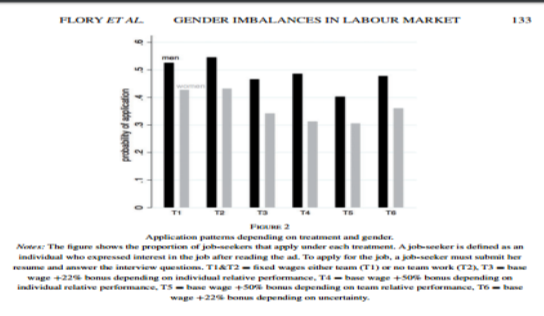Do Competitive Workplaces Deter Female Workers?
Â
Â

Introduction
The gender gap in the labour market exist whether you measure it by wages or promotions to name a few. Galor and Weil (1996) mention negative consequences of this is being “economic growth and fertility.” In this area of researching their have been several papers all with different hypothesis’s to explain why. The more recent being Niederle and Vesterlund (2007) stating that “women shy away from competitive workplaces whereas men desire , and even thrive in.”
  This is what Flory et al article offers. Providing evidence on the extent to which these findings predict behaviour in naturally occurring labour marketing’s and what the economic consequences are. Advancing it by analysing subjects in a natural labour market making economic choices. The difference with it being in a field experiment is the loosening of the degrees of controls over factors which in a normal laboratory experiment be easily to manipulate. So able to provide more realistic insight into the question where laboratory settings are unrealistic, through manipulations in the field, able to examine whether persisting gender gap in labour markets can be accredited to a certain degree by different compensation regimes.
    To test this they conduct two natural field experiment on job entry decisions. Posting two versions of an online advertisement and randomized interested jobseekers into different compensation regimes. Each job seeker then makes the decision whether to ultimately. Comparing application patterns for the two versions of position makes it possible to establish the relevance of task-dependence and gender-job associations. The second experiment explores an mechanism behind gender specific employment patterns which is gender – job associations. This was emphasized by Akerlof and Kranton (2000) who used mechanism to predict “that women sort into employments whose requirements match construed female attributes.” More recent papers suggest different responses by men and women to competition may depend partly on the tasks performed like Shurchkov (2012) who found “men are much more willing to compete in the lab when using a math task disappears when switching to a verbal task suggesting gender-task stereotypes drive such gender differences”. So second experiment sees whether minor adjustments in the position, affect each gender’s response to the contract environment.
DESIGN
    The first experiment is 2x6x2 model, Vary by employment advertisement, compensation scheme, and application procedure. It was ran in 16 cities. By doing this they manage to isolates certain parts of the contract environment on the job seekers who stayed interested after being informed Second experiment holds the general reward structure constant, but varies gender composition. Run across 12 cities with different job-seekers. They implanted a two stage experimental method. First advertise position without knowledge. Second after express interest, inform the subject of either the compensation scheme or gender composition. Record who applies. The method allowed clean randomize across subjects within each city and within same time period Also gain individual characteristics on everyone even job-seekers who after being informed did not apply. Cities were selected to due to being able represent a variety of cities in US in regards to its geology location and therefore the different market wages which exist in each city and maximise the pool of job seekers from each area
Natural field experiment I:
   They posted an advert for admin assistant. Chosen because it is the most common job and significant gender gap in wages. Two versions produce to capture broadest sample. Posted two days apart to avoid any subject believing applying for both jobs when just applying for one.
  They posted an advert for admin assistant. Chosen because it is the most common job and significant gender gap in wages. Two versions produce to capture broadest sample. Posted two days apart to avoid any subject believing applying for both jobs when just applying for one.
 Flory 1. Flory, J., Leibbrandt, A. and List, J. (2015) ”Do Competitive Workplaces Deter Female Workers? A Large Scale Natural Field Experiment on Job Entry Decisions”, Review of Economic Studies, (), pp. 128.
   Compensation scheme treatments randomized subjects who expressed interest in one of six treatments. Table 1 shows characteristics of the treatments from both experiments. First two use same compensation scheme, fixed-wage, differ whether job done in teams (T1) or alone (T2).Next two are individual tournament-based salary regimes. Individual tournament-low (T3) and high (T4) treatment. T5, is group-based competition.
T6 is to see if there is gender difference in attitudes towards uncertainty when compared to the completion treatments.
Natural Field experiment II
Used to see the mechanism which may explain the findings for the first experiment do this by gender composition treatments. Procedure identical expect post only the sport ad and different treatments. Compensation structure identical to T4 expect manipulate gender structure of contract. Test whether findings from first experiment driven by expected gender composition of environment. 2Ta and 2Tb provide information on competitor’s gender. 2Tc and 2Td provide information on supervisor’s gender. Final treatment, 2T6, like T6 is on uncertainty they do this by introducing heavy wage uncertainty
  Defining subject as any individual who contacted them to express interest in job. In order to apply, job-seeker had to fill out and return a questionnaire. So classify subjects as those who returned questionnaire to them as having applied. They mention an experiment problem which was determining subject’s gender. Since there are legal issues for asking for subjects gender, for example discrimination laws where cannot hire someone based on gender. It also could offend subjects who may because of being asked alter their decision so effecting the results of experiment. They employ three-tier method. Flory et al used Social Security Administration database first then the G. Peters database. And finally would, perform internet searches for individual subject to find out their gender. To gain all the other characteristics of the sample size was done by the gathering the resumes.
Results
Table 2 below shows the summary statistic of both experiments.

Flory 1. Flory, J., Leibbrandt, A. and List, J. (2015) ”Do Competitive Workplaces Deter Female Workers? A Large Scale Natural Field Experiment on Job Entry Decisions”, Review of Economic Studies, (), pp. 132.

Flory 1. Flory, J., Leibbrandt, A. and List, J. (2015) ”Do Competitive Workplaces Deter Female Workers? A Large Scale Natural Field Experiment on Job Entry Decisions”, Review of Economic Studies, (), pp. 133.
Comparing the application probabilities of all the treatments to the T1 and T2, the patterns lead to the first result: “Competitive workplaces can significantly increase the gender gap in application probabilities” (Flory et al. pp. 134.) For the position which advertises pay that depends heavily on performance against someone else. Women’s probability of applying significantly drops when compared to the men. However the problem with result one is when comparing to other literature since most other relevant studies use a single undifferentiated task while in this experiment the data collected was from are a two different versions of a job which differ in their gender-connotations. However as stated first result is seen in both version. Another problem comparing other literature is the demographic of subjects mainly in age. Since this experiment age is more diverse then in the normal laboratory setting .This leading them to state if gender gap driven by younger subjects the results will have a weaker precision and magnitude of the estimates in comparison to other literature.
    Relevant studies suggests gender differences in choices over competition are driven partly by men being risk – loving while women more risk – aversion. Therefore men will pursue more competition. . This contradicts Flory et al second result: The observed gap is not driven by men being attracted to the competitive work environment and women shunning it, but rather by a significantly stronger aversion to competitive workplaces among women compared to men. (Flory et al. pp. 135.) They discovered that both genders are more interested in non-competitive work environments than competitive. As see in figure two where application probabilities drop for both genders when moving from T1 and T2 to compensation depending on subject besting an opponent (T3 & T4). However in figure 2 you see that men’ application probability drop is smaller than females. Sheds light since may derive not only from differences in the choice environment. Since natural field setting has less degree of control compared to a laboratory setting which most other relevant papers are set in a lab.  Another is due to the older age among subjects in these two experiment field compared to the standard subject age pool which normally undergraduates so 18-21 in the literature.
   Their analysis of the data found the causes of the changes in application probabilities. Also shows which factors would weaken or worsen the gender gap. Giving them the third result :”Several factors related to the workplace affect the gender gap, including: (i) the degree to which compensation depends on relative performance, (ii) whether the job is team based, and (iii) minor changes in the job task. (Flory et al. pp. 136.)). So meaning that everything being constant expect just changing the contract from a fixed wage to compensation, (dependent on the individuals performance against their competitor) has no significant impact on the gender gap in application probabilities. Found subjects were given contracts with the T5 treatment reduced the gender gap. Thus, the gender gap in application probabilities remained constant when moving from T1 & T2 which had fixed wage so independent from performance to T5 which depended on the team’s performance.
  Flory 1. Flory, J., Leibbrandt, A. and List, J. (2015) ”Do Competitive Workplaces Deter Female Workers? A Large Scale Natural Field Experiment on Job Entry Decisions”, Review of Economic Studies, (), pp. 138.
 Flory 1. Flory, J., Leibbrandt, A. and List, J. (2015) ”Do Competitive Workplaces Deter Female Workers? A Large Scale Natural Field Experiment on Job Entry Decisions”, Review of Economic Studies, (), pp. 138.
 Recent papers suggests that men and women responded differently to competition may be affected by what task is needed to be performed (Shurchkov, 2012). To examine this hypothesis by using second experiment since the two versions have same task just one seems to have more male overtones. See Figure 3 and 4 which shows when moving the job tasks from sports to just general job duties. Men going from being indifferent to the T4 treatment to being deterred by it. Meanwhile, women remain equally deterred by it, causing gender gap to vanish. One explanation for this is that subjects have bias expectations about the gender of their competitor so therefore have different preferences when competing against members of the same and opposite gender. For example men believe they are better skilled then women in sport but equals in general. Men would then expect in the T4 treatment to earn a higher wage in sports version, as long as they believe their competitor will be a woman. This led to men applying for T4 treatment in sport version but not general . However the results of their second experiment makes this interpretation inconsistent.
  As figure 3 and 4 show that for males knowing the gender of their coworker-competitor has an insignificant effect on their response to T4. These findings are summarized in fourth result: The gender of the coworker-competitor in the high-stakes relative performance pay scheme has no measurable effect on the gender gap. (Flory et al. pp. 143.) If the gender gap induced by T4 in the sports-related version of the job were driven by beliefs among both genders about differences in ability between men and women, then knowing the gender of the coworker would have an effect on the gender gap. However this interpretation again is not seen in second experiment results. A closer look into the first experiment data provide further support in this hypothesis that beliefs about ability are driving the results. If behavior is being driven by the fact that women’s expected wages under T4 are lower in the sports-related version of the position where more of a gap than in the more general version. Expect to see T4 have a hindering effect on female applications only in the sports-version. However, results say that general aversion to competitive workplaces among women in both versions. However this was not the design of sports was not to give advantage to men but rather manipulate gender association of the job. So if it stereotype true women for example were better at verbal tasks then having specific subject matter (sports) seems unlikely to have strong effects on beliefs over how good each gender will be at the job.
 The next hypothesis was on gender discrimination which is that workers are respond to their beliefs about gender-based discrimination in performance evaluation. This would lead them to believe that discrimination will affect the expected wages they receive in. Using second experiment use treatments 2Tc and 2Td which manipulate the gender of the boss , who evaluates performance, to test for evidence that women believe they will be discriminated against by superiors of a specific gender. Resulting in fifth result: The gender of the supervisor in the high-stakes relative performance pay scheme has no significant effect on the gender gap (Flory et al. pp. 144.) An interpretation of the result is women are not responding to a concern of being judged unfairly by their boss so end up with a lower wage to male counterpart. Also vice versa of men are not responding to preferment treatment.
 The final hypothesis is men and women respond differently to risk and uncertainty with Borghans et al, (2009) paper showing evidence of this. This may explain why women sometimes deter from competitions. In Niederle and Vesterlund (2007) paper they argue for the existence of systematically different preferences between men and women over competition per se, independent from preferences over risks and other factors. However authors to mention limitations to their research like imperfect controls meaning the gender gap can be driven still by gender preference to things such as risk aversion, rather than by an independent taste for competition. The second natural field experiment sheds light on whether job-seekers in the field are as sensitive to uncertainty as to competition. This leads to sixth result: Large wage uncertainty has almost the same effect on the gender gap in application rates as the high-stakes relative performance scheme. (Flory et al. pp. 146.)One interpretation of this result is preferences over uncertainty can potentially explain gender’s choices over competition. Another is that both uncertainty and competition are independent factors but there effects are of similar magnitude.
They conclude the results by stating the most plausible explanations for the gender difference are in the gender’s preference of uncertainty and competition. Since these underlying factors show the effects that were found by having competition incentives in the workplace on gender composition among applicants.
Conclusion
They comment that their paper relates to other field experimental studies considering gender differences. Such as Buser et al., (2014) which showed extent to which laboratory competition measures are related to individual education choices, which can have important later impacts on labour market outcomes. Their findings suggest that broader market conditions are important for the strength and presence of the gender difference, and that women are responding appropriately to “prices,” in the sense that they are trading off lower fixed wages with more competitive job environments.
However they acknowledge some limitations in their study. One is that they choice a specific job in experiment they say if the job type interacts with the effect of competition incentives on the gender gap is an important issue that remains unresolved in this paper. They also only examine observe the first step in hiring process not entire hire process. Limit since additional aspects of the labour market may also play role in final worker sorting in learning about the ultimate distribution of workers. Finally the demographic of subjects in experiment differ to the typical admin assistant in terms of age and education. As Flory et al (page 152) state that after they robusted the behaviour patterns across these different subsets of the population and different choice environments suggests their results are likely to extend to other occupational settings.
References
- Flory, J., Leibbrandt, A. and List, J. (2015) ‘Do Competitive Workplaces Deter Female Workers? A Large Scale Natural Field Experiment on Job Entry Decisions’, Review of Economic Studies, 2015.
- Galor, O and Weil, D (1996) ‘The Gender Gap, Fertility and Growth’ American Economic Review 376-387.
- Niederle, M, and Vesterlund, L (2011) ‘ Gender and Competition’ Annual Review of Economics, 601-630
- Akerlof,G, and Kranton, R (2006) ‘Economics and Identify’ Quarterly Journal of Economics’ 715-753
- Shurchkov, O, (2012) ‘Under Pressure, Gender Difference in Output Quality and Quantity Under Competition and Time Constraints’ Journal of the European Economic Assocation 1189-1213
- Borghans, L, Golsteyn, B, Heckman, J and Meijers, H (2009) ‘Gender Difference in Risk Aversion and Ambiguity Aversion’ Journal of the European Economic Association 649 – 658.
- Niederle, M, and Vesterlund, L (2007) ‘Do Women Shy Away From Competition? Do Men Compete Too Much? Quarterly Journal of Economics, 1067-1101
- Buser, T, Niederle, M and Oosterbeek, H (2014) ‘Gender Competitiveness and Career Choice’ the Quarterly Journal of Economics 1409-1447.